Evolution of a Late Miocene Deep-Water Depositional System in the Southern Taranaki Basin, New Zealand
Abstract
:1. Introduction
2. Geologic Setting
2.1. Geologic Background
2.2. Mount Messenger Depositional System
3. Data and Methods
3.1. Seismic Datasets
3.2. Well Data
3.3. Seismic Analysis
3.4. Proportional Slicing
3.5. Seismic Attributes
4. Results
4.1. Pipeline 3D Study Area
4.2. Hector 3D Study Area
5. Discussion
5.1. Temporal Evolution
5.2. Depositional Environments
6. Conclusions
Author Contributions
Funding
Data Availability Statement
Acknowledgments
Conflicts of Interest
References
- Browne, G.H.; Slatt, R.M. Outcrop and behind-outcrop characterization of a Late Miocene slope fan (channel-levee complex), Mt Messenger Formation, New Zealand. Am. Assoc. Pet. Geol. Bull. 2002, 86, 841–862. [Google Scholar]
- King, P.R.; Browne, G.H.; Arnot, M.J.; Slatt, R.M.; Helle, K.; Stromsoyen, I. A 2-D oblique-dip outcrop transect through an entire third-order, progradational, deep-water clastic succession (Late Miocene Mount Messenger-Urenui Formations), Taranaki Basin, New Zealand. Atlas of deep-water outcrops. AAPG Stud. Geol. 2007, 56, 238–240. [Google Scholar]
- King, P.R.; Ilg, B.R.; Arnot, M.; Browne, G.H.; Strachan, L.J.; Crundwell, M.; Helle, K. Outcrop and Seismic Examples of Mass-Transport Deposits from a Late Miocene Deep-Water Succession, Taranaki Basin, New Zealand. Mass-Transp. Depos. Deep. Settings 2011, 96, 311–348. [Google Scholar] [CrossRef]
- Baur, J.R.; King, P.R.; Stern, T.; Leitner, B. Development and Seismic Geomorphology of a Miocene Slope Channel Megasystem, Offshore Taranaki Basin, New Zealand. In Seismic Imaging of Depositional and Geomorphic Systems: SEPM Foundation, Gulf Coast Section, 30th Annual Research Conference Proceedings; SEPM Society for Sedimentary Geology: Tulsa, OK, USA, 2011; pp. 618–649. [Google Scholar] [CrossRef]
- King, P.R.; Browne, G.H. Miocene turbidite reservoir systems in the Taranaki Basin. In New Zealand: Established Plays and Analogues for Deep-Water Exploration: PESA Eastern Australasian Basins Symposium; Positive Education Schools Association: Melbourne, VIC, Australia, 2001; pp. 129–139. [Google Scholar]
- King, P.R.; Thrasher, G.P. Cretaceous-Cenozoic Geology and Petroleum Systems of the Taranaki Basin, New Zealand; Institute of Geological and Nuclear Sciences Monograph 13. 6 enclosures; Institute of Geological & Nuclear Sciences Limited: Lower Hutt, New Zealand, 1996; p. 243. [Google Scholar]
- Browne, G.H.; King, P.R.; Higgs, K.E.; Slatt, R.M. Grain-size characteristics for Distinguishing Basin floor fan and slope Fan depositional settings: Outcrop and Subsurface examples from the late Miocene Mount Messenger Formation, New Zealand. N. Zeal. J. Geol. Geophys. 2005, 48, 213–227. [Google Scholar] [CrossRef]
- Reilly, C.; Nicol, A.; Walsh, J.J.; Seebeck, H. Evolution of faulting and plate boundary deformation in the Southern Taranaki Basin, New Zealand. Tectonophysics 2015, 651–652, 1–18. [Google Scholar] [CrossRef]
- Bull, S.; Nicol, A.; Strogen, D.; Kroeger, K.F.; Seebeck, H.S. Tectonic controls on Miocene sedimentation in the Southern Taranaki Basin and implications for New Zealand plate boundary deformation. Basin Res. 2019, 31, 253–273. [Google Scholar] [CrossRef]
- Holt, W.E.; Stern, T.A. Subduction, platform subsidence, and foreland thrust loading: The late Tertiary development of Taranaki Basin, New Zealand. Tectonics 1994, 13, 1068–1092. [Google Scholar] [CrossRef]
- Rotzien, J.R.; Browne, G.H.; King, P.R. Geochemical, petrographic, and uranium–lead geochronological evidence for multisourced polycyclic provenance of deep-water strata in a hybrid tectonic setting: The upper Miocene upper Mount Messenger Formation, Taranaki Basin, New Zealand. AAPG Bull. 2018, 102, 1763–1802. [Google Scholar] [CrossRef]
- Arnot, M.J.; Bland, K.J.; Strogen, D.P.; Seebeck, H.C.; Bull, S.; Town, C.C.; Griffin, A.G.; Viskovic, G.P.D.; Hill, M.G.; Thrasher, G.; et al. Atlas of Petroleum Prospectivity, Northwest Province: ArcGIS Geodatabase and Technical Report, GNS Science Data Series 23b 34 p. + 1 ArcGIS Geodatabase + 5 ArcGIS Projects, New Zealand; GNS Science: Lower Hutt, New Zealand, 2016. [Google Scholar]
- Strogen, D.P.; Bland, K.J.; Nicol, A.; King, P.R. Paleogeography of the Taranaki Basin region during the latest Eocene–Early Miocene and implications for the ‘total drowning’ of Zealandia. N. Z. J. Geol. Geophys. 2014, 57, 110–127. [Google Scholar] [CrossRef]
- Laird, M.G.; Bradshaw, J.D. The Break-up of a Long-term Relationship: The Cretaceous Separation of New Zealand from Gondwana. Gondwana Res. 2004, 7, 273–286. [Google Scholar] [CrossRef]
- Vonk, A.J.; Kamp, P.J.J. The Late Miocene Southern and Central Taranaki Inversion Phase (SCTIP) and related sequence stratigraphy and paleogeography. In Proceedings of the 2008 New Zealand Petroleum Conference, Auckland, New Zealand, 9–12 March 2008. [Google Scholar]
- Hansen, R.J.; Kamp, P.J.J. Evolution of the Giant Foresets Formation, northern Taranaki Basin, New Zealand. In Proceedings of the New Zealand Petroleum Conference, 24–27 February 2002; Crown Minerals, Ministry of Economic Development: Wellington, New Zealand, 2002. [Google Scholar]
- Strogen, D.P.; Bland, K.J.; Baur, J.R.; King, P.R.; Vonk, A.J.; Kamp, P.J.J. Neogene: Active margin tectonics. In Updated Paleogeographic Maps for the Taranaki Basin and Surrounds; GNS Science Report, 2011; Strogen, D.P., Compiler; GNS Science: Lower Hutt, New Zealand, 2010; pp. 36–60. [Google Scholar]
- King, P.; Browne, G.; Slatt, R. Sequence Architecture of Exposed Late Miocene Basin Floor Fan and Channel-Levee Complexes (Mount Messenger Formation), Taranaki Basin, New Zealand; SEPM Society for Sedimentary Geology: Tulsa, OK, USA, 1994; Volume 15. [Google Scholar]
- Browne, G.H.; Strachan, L.J.; King, P.R.; Malcolm, J.A. Mass-transport complexes from a late Miocene deep-water succession, Taranaki Basin, New Zealand: Scales, styles, and significance in relation to tectonic, eustatic, and autocyclic drivers. Search Discov. Artic. 2006, 50040. [Google Scholar]
- Rotzien, R.J.; Lowe, D.R.; King, P.R.; Browne, G.H. Stratigraphic architecture and evolution of a deep-water slope channel-levee and overbank apron: The Upper Miocene Upper Mount Messenger Formation, Taranaki Basin. Mar. Pet. Geol. 2014, 52, 22–41. [Google Scholar] [CrossRef]
- Strong, C.P.; Wilson, G.J. Taranaki Basin, New Zealand: Biostratigraphic Reassessment (Foraminifera and Dinoflagellates) of Key Western Platform Wells; GNS Science Report 2002; GNS Science: Lower Hutt, New Zealand, 2002. [Google Scholar]
- Roncaglia, L.; Fohrmann, M.; Milner, M.; Morgans, H.E.G.; Crundwell, M.P. Well Log Stratigraphy in the Central and Southern Offshore Area of the Taranaki Basin, New Zealand; GNS Science Report, 2013/27, 26p + enclosures; GNS Science: Lower Hutt, New Zealand, 2013. [Google Scholar]
- Janocko, M.; Nemec, W.; Henriksen, S.; Warchoł, M. The diversity of deep-water sinuous channel belts and slope valley-fill complexes. Mar. Pet. Geol. 2013, 41, 7–34. [Google Scholar] [CrossRef] [Green Version]
- Miall, A.D. Architectural-Element Analysis: A New Method of Facies Analysis Applied to Fluvial Deposits; Recognition of Fluvial Depositional Systems and Their Resource Potential; SEPM Society for Sedimentary Geology: Tulsa, OK, USA, 1985; pp. 33–81. [Google Scholar] [CrossRef]
- Davies, R.J. Seismic Geomorphology: Applications to Hydrocarbon Exploration and Production; The Geological Society: London, UK, 2007. [Google Scholar]
- Marfurt, K.J.; Kirlin, R.L.; Farmer, S.L.; Bahorich, M.S. 3-D seismic attributes using a semblance-based coherency algorithm. Geophysics 1998, 63, 1150–1165. [Google Scholar] [CrossRef] [Green Version]
- Chopra, S.; Marfurt, K.J. Gleaning meaningful information from seismic attributes. First Break 2008, 26. [Google Scholar] [CrossRef] [Green Version]
- Chopra, S.; Marfurt, K.J. Volumetric curvature attributes add value to 3D seismic data interpretation. Lead. Edge 2007, 26, 856–867. [Google Scholar] [CrossRef]
- Partyka, G.; Gridley, J.; Lopez, J. Interpretational applications of spectral decomposition in reservoir characterization. Lead. Edge 1999, 18, 353–360. [Google Scholar] [CrossRef] [Green Version]
- Laughlin, K.; Garossino, P.; Partyka, G. Spectral decomposition applied to 3D. AAPG Explor. 2002, 23, 28–31. [Google Scholar]
- Li, F.; Qi, J.; Marfurt, K. Attribute mapping of variable-thickness incised valley-fill systems. Lead. Edge 2015, 34, 48–52. [Google Scholar] [CrossRef] [Green Version]
- Silver, C.; Bedle, H. Overbank Sediment Waves in the Southern Taranaki Basin, New Zealand. Interpretation 2021, 9, C11–C15. [Google Scholar] [CrossRef]
- Chenin, J.; Silver, C.; Bedle, H. Seismic geomorphology anomalies within a Pliocene deepwater channel complex in the Taranaki Basin, offshore New Zealand. Interpretation 2021, 9, C1–C10. [Google Scholar] [CrossRef]
- Snedden, J.W. Channel-body basal scours: Observations from 3D seismic and importance for subsurface reservoir connectivity. Mar. Pet. Geol. 2013, 39, 150–163. [Google Scholar] [CrossRef]
- Abreu, V.; Sullivan, M.; Pirmez, C.; Mohrig, D. Lateral accretion packages (LAPs): An important reservoir element in deep water sinuous channels. Mar. Pet. Geol. 2003, 20, 631–648. [Google Scholar] [CrossRef]
- Posamentier, H.W. Depositional elements associated with a basin floor channel-levee system: Case study from the Gulf of Mexico. Mar. Pet. Geol. 2003, 20, 677–690. [Google Scholar] [CrossRef]
- Baur, J.R. Regional Seismic Attribute Analysis and Tectono-stratigraphy of Offshore South-western Taranaki Basin, New Zealand. Ph.D. Thesis, Victoria University of Wellington, Wellington, New Zealand, 2012. [Google Scholar]
- Kamp, P.J.; Green, P.F. Thermal and tectonic history of selected Taranaki Basin (New Zealand) wells assessed by apatite fission track analysis. AAPG Bull. 1990, 74, 1401–1419. [Google Scholar]
- McHargue, T.; Pyrcz, M.J.; Sullivan, M.D.; Clark, J.D.; Fildani, A.; Romans, B.W.; Covault, J.A.; Posamentier, H.W.; Drinkwater, N.J. Architecture of turbidite channel systems on the continental slope: Patterns and predictions. Mar. Pet. Geol. 2011, 28, 728–743. [Google Scholar] [CrossRef]
- Sprague, A.R.; Sullivan, M.D.; Campion, K.M.; Jensen, G.N.; Goulding, F.J.; Garfield, T.R.; Sickafoose, D.K.; Rossen, C.; Jennette, D.C.; Beaubouef, R.T.; et al. The physical stratigraphy of deep-water strata: A hierarchical approach to the analysis of genetically-related stratigraphic elements for improved reservoir prediction. In Proceedings of the AAPG Annual Meeting, Houston, TX, USA, 10–13 March 2002; pp. 10–13. [Google Scholar]
- Bouma, A.H. Key Controls on the Characteristics of Turbidite Systems; Special Publications; Geological Society: London, UK, 2004; Volume 222, pp. 9–22. [Google Scholar] [CrossRef]
- Reading, H.G.; Richards, M. Turbidite Systems in Deep-Water Basin Margins Classified by Grain Size and Feeder System. AAPG Bull. 1994, 78, 792–822. [Google Scholar] [CrossRef]



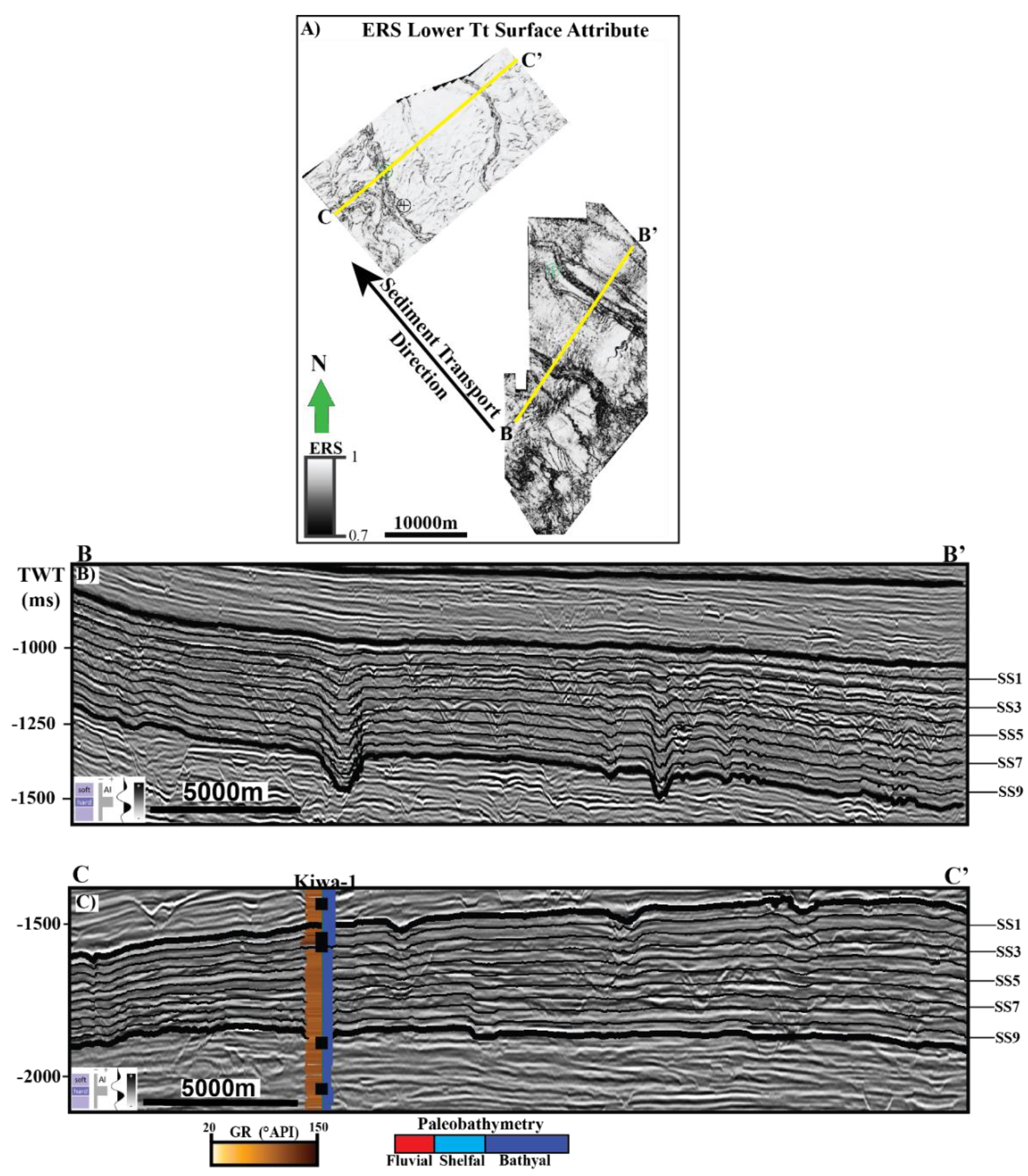
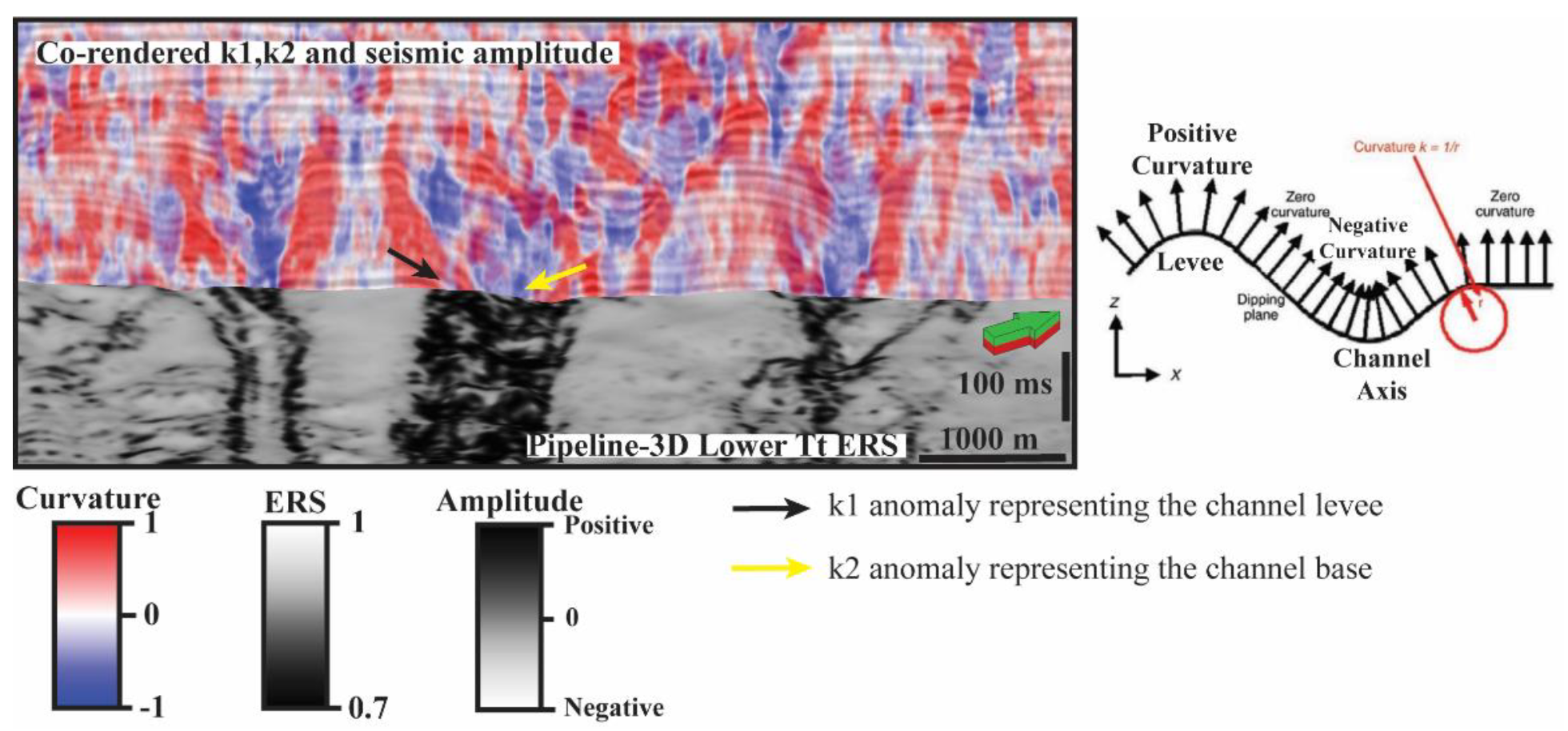
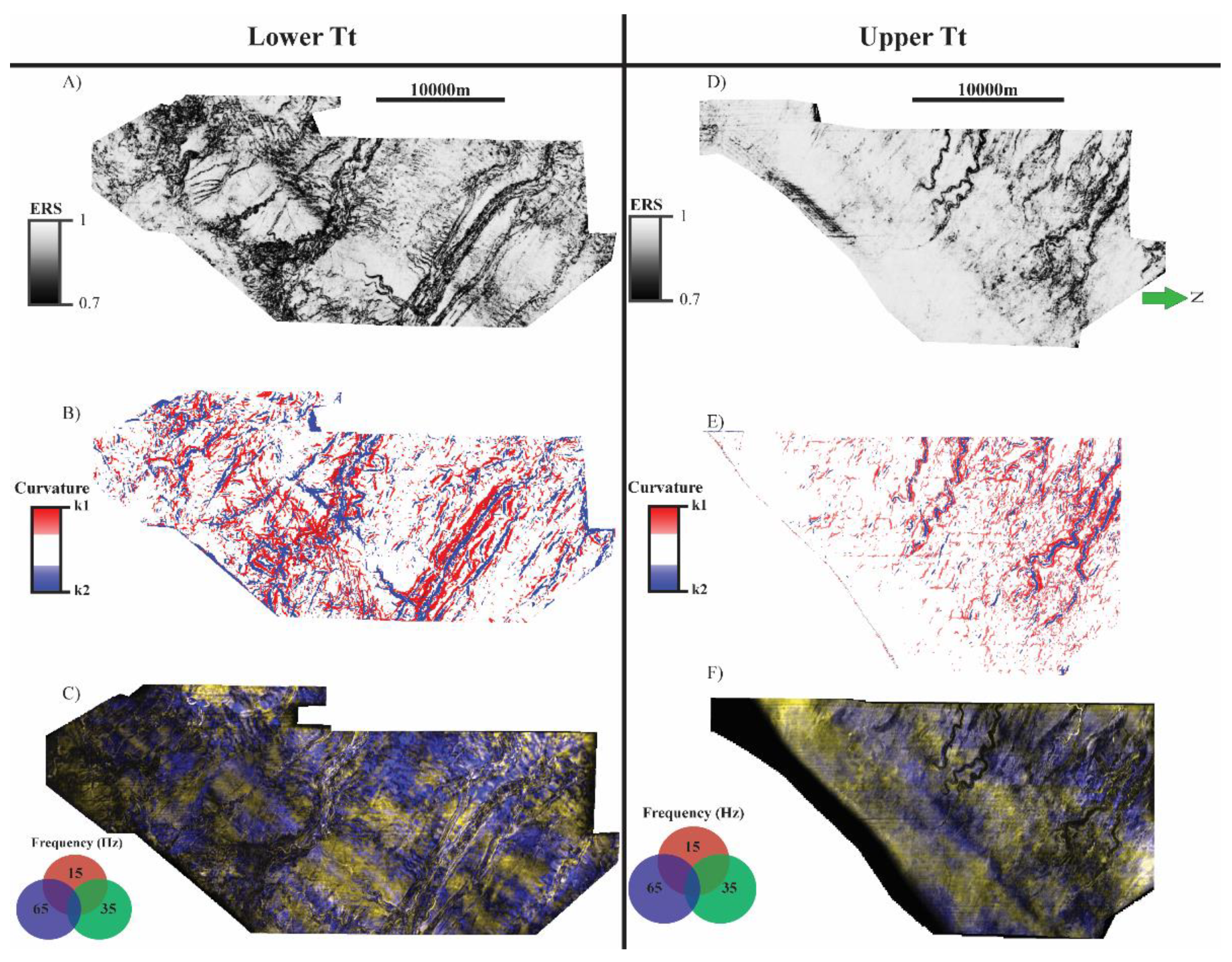


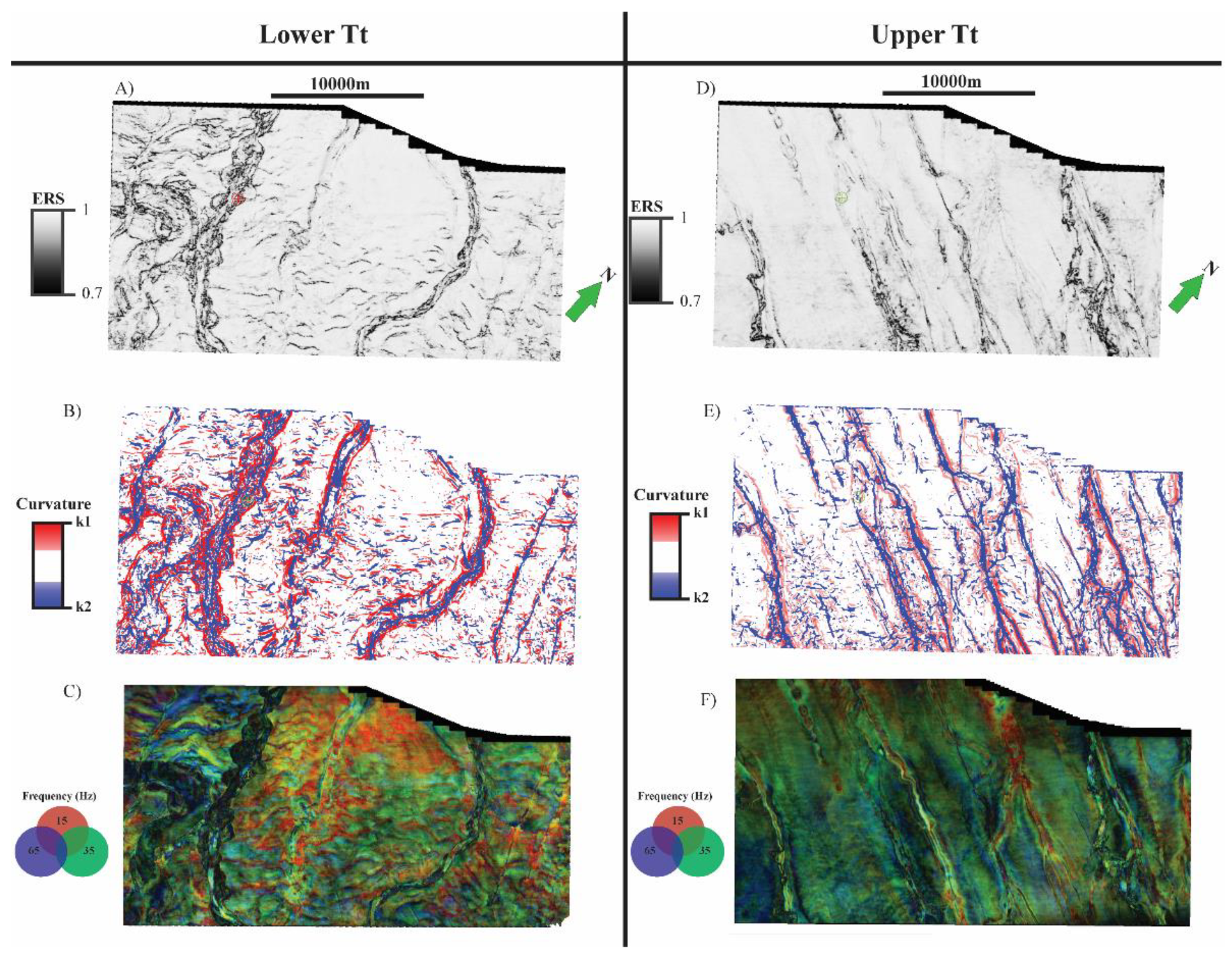
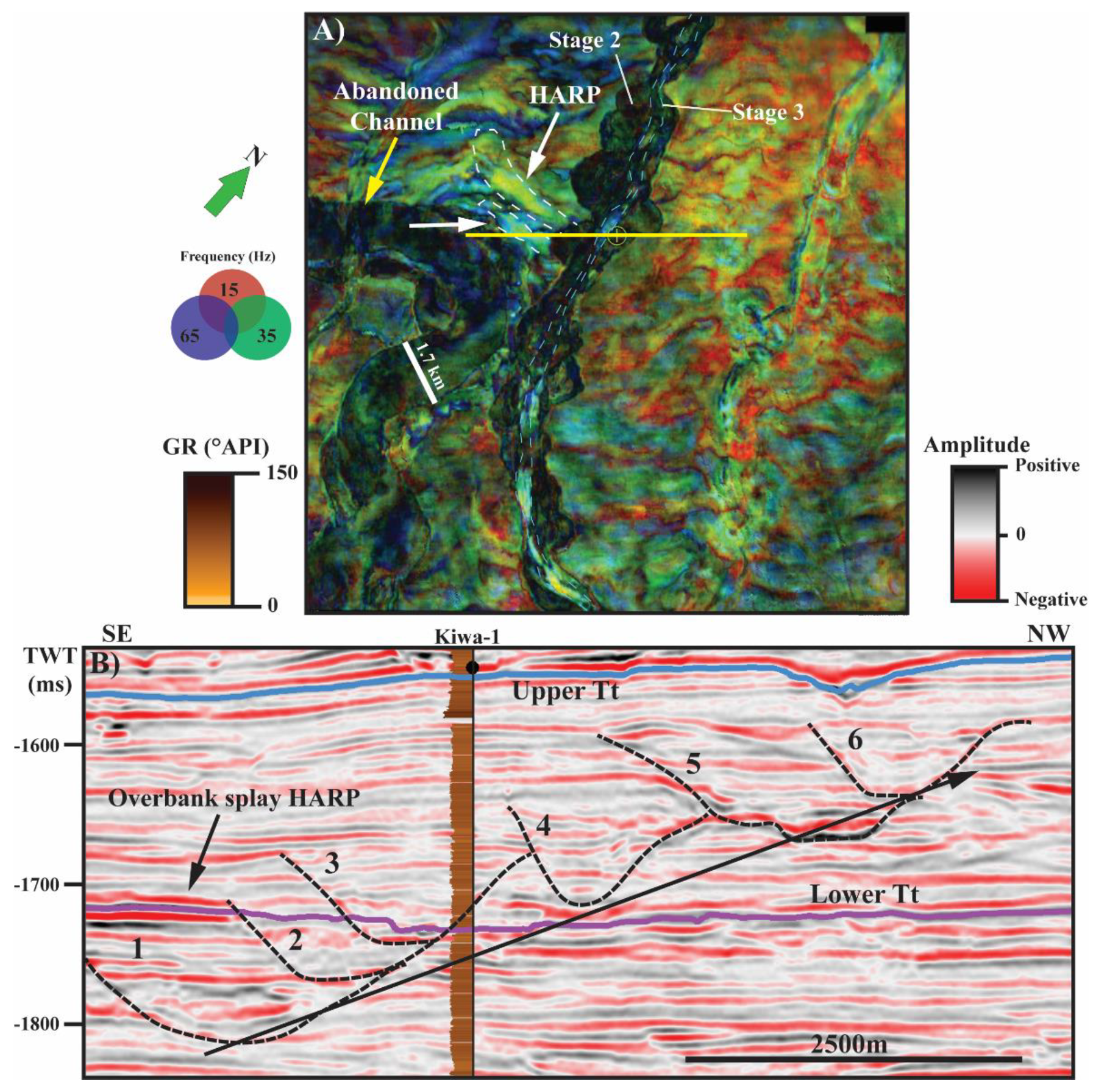

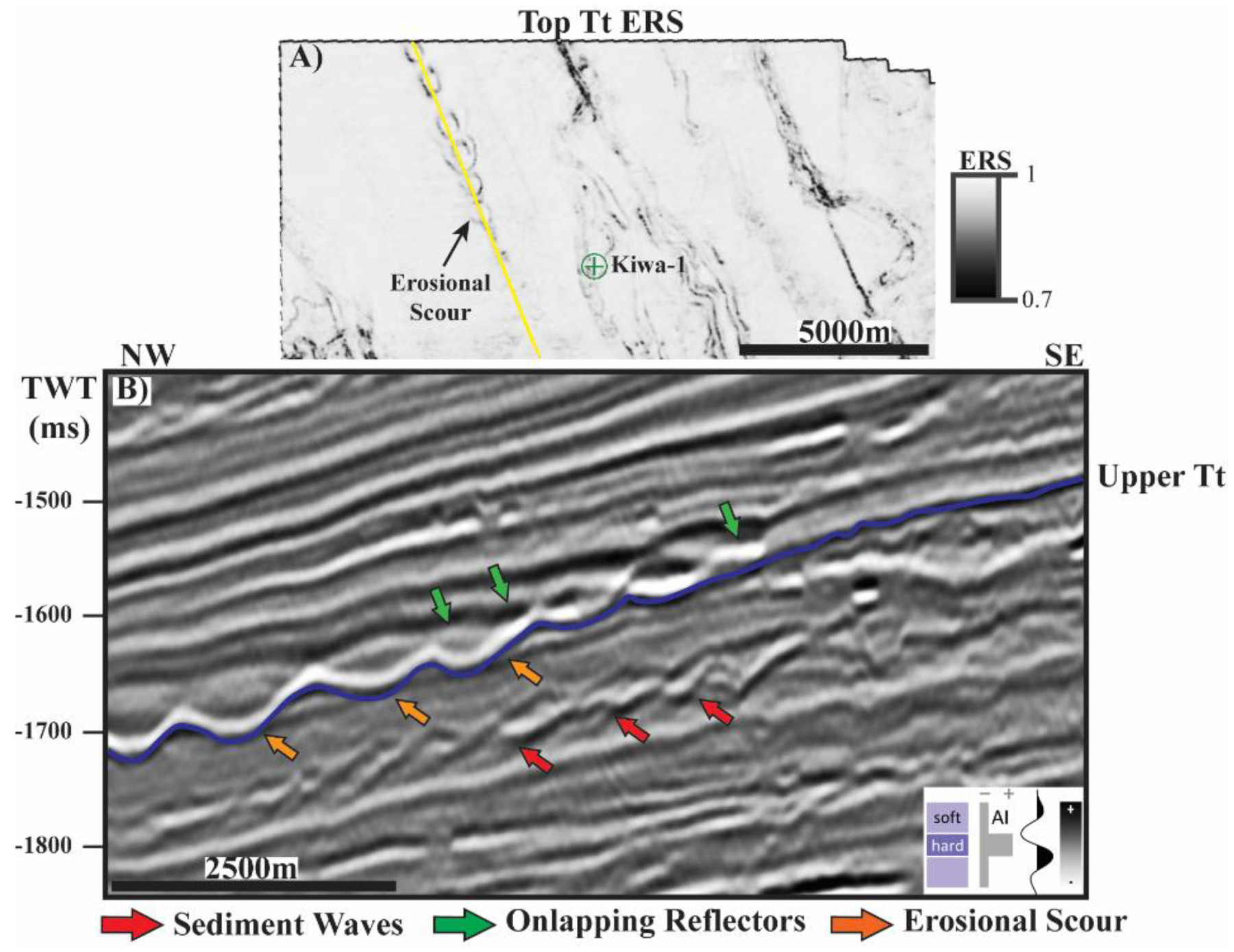

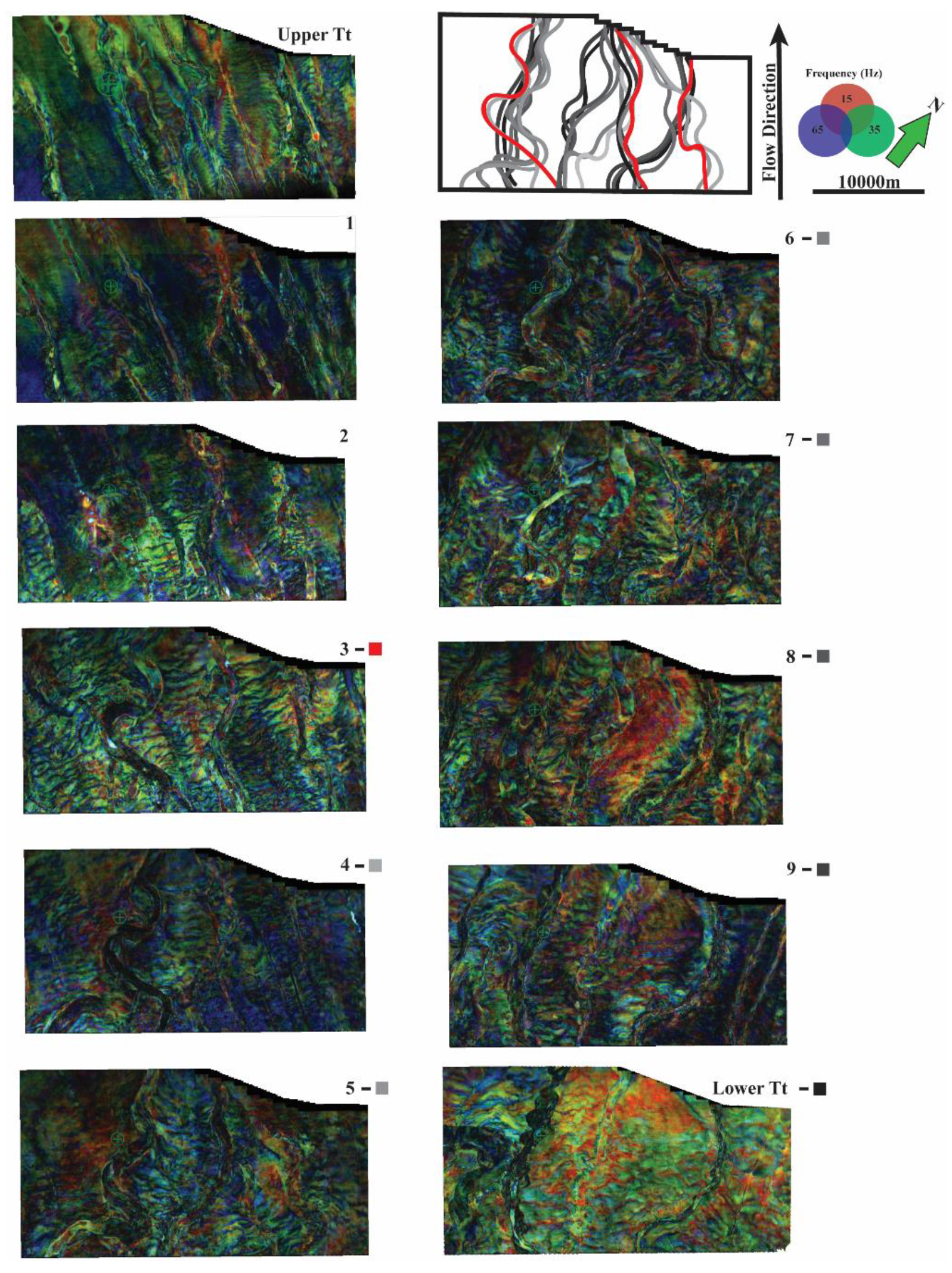

Publisher’s Note: MDPI stays neutral with regard to jurisdictional claims in published maps and institutional affiliations. |
© 2021 by the authors. Licensee MDPI, Basel, Switzerland. This article is an open access article distributed under the terms and conditions of the Creative Commons Attribution (CC BY) license (https://creativecommons.org/licenses/by/4.0/).
Share and Cite
Silver, C.; Bedle, H. Evolution of a Late Miocene Deep-Water Depositional System in the Southern Taranaki Basin, New Zealand. Geosciences 2021, 11, 329. https://doi.org/10.3390/geosciences11080329
Silver C, Bedle H. Evolution of a Late Miocene Deep-Water Depositional System in the Southern Taranaki Basin, New Zealand. Geosciences. 2021; 11(8):329. https://doi.org/10.3390/geosciences11080329
Chicago/Turabian StyleSilver, Clayton, and Heather Bedle. 2021. "Evolution of a Late Miocene Deep-Water Depositional System in the Southern Taranaki Basin, New Zealand" Geosciences 11, no. 8: 329. https://doi.org/10.3390/geosciences11080329
APA StyleSilver, C., & Bedle, H. (2021). Evolution of a Late Miocene Deep-Water Depositional System in the Southern Taranaki Basin, New Zealand. Geosciences, 11(8), 329. https://doi.org/10.3390/geosciences11080329





